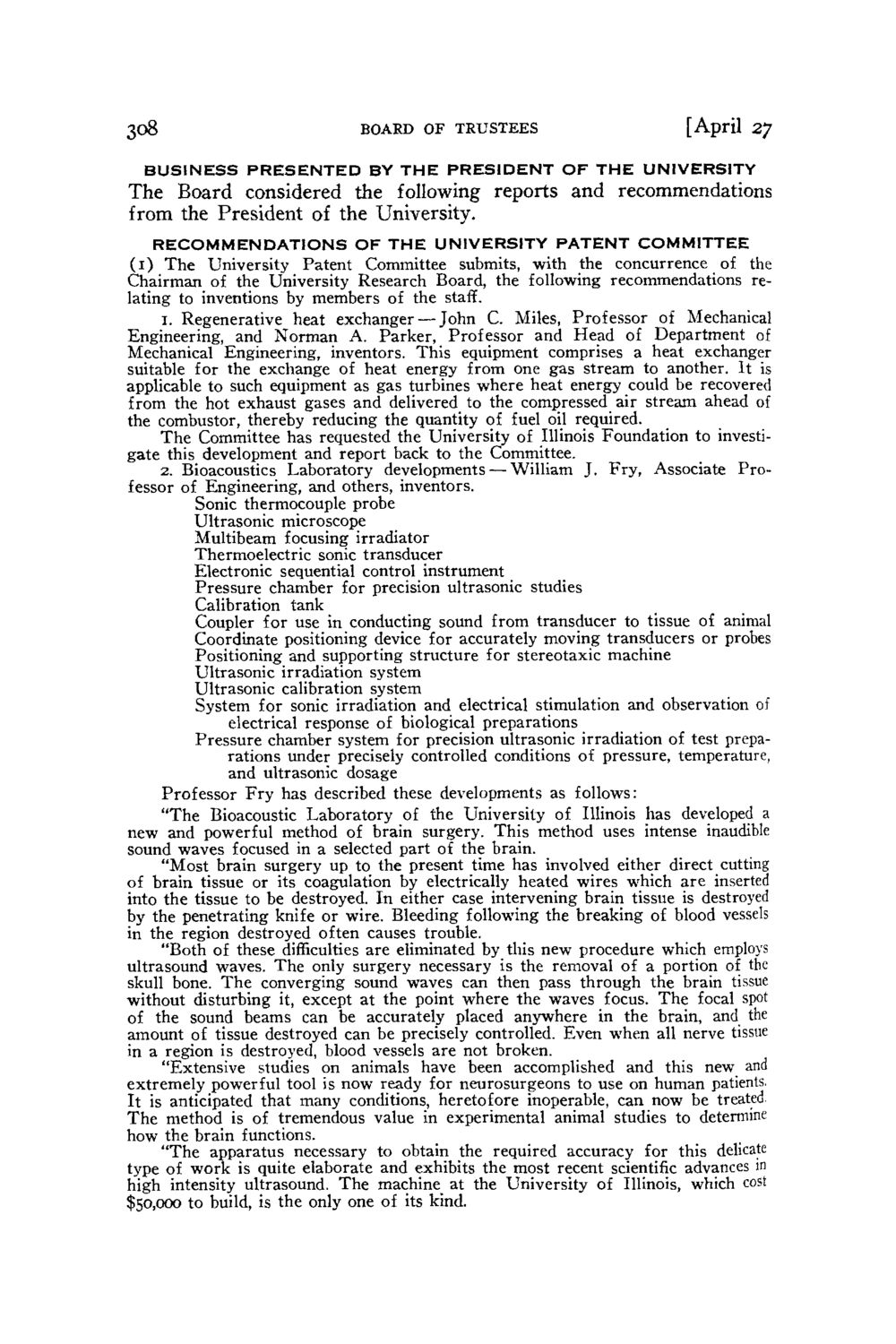| |
| |
Caption: Board of Trustees Minutes - 1956
This is a reduced-resolution page image for fast online browsing.

EXTRACTED TEXT FROM PAGE:
3o8 BOARD OF TRUSTEES [April 27 B U S I N E S S P R E S E N T E D BY T H E P R E S I D E N T O F THE UNIVERSITY The Board considered the following reports and recommendations from the President of the University. R E C O M M E N D A T I O N S O F T H E UNIVERSITY PATENT COMMITTEE (1) The University Patent Committee submits, with the concurrence of the Chairman of the University Research Board, the following recommendations relating to inventions by members of the staff. 1. Regenerative heat exchanger — John C. Miles, Professor of Mechanical Engineering, and Norman A. Parker, Professor and Head of Department of Mechanical Engineering, inventors. This equipment comprises a heat exchanger suitable for the exchange of heat energy from one gas stream to another. It is applicable to such equipment as gas turbines where heat energy could be recovered from the hot exhaust gases and delivered to the compressed air stream ahead of the combustor, thereby reducing the quantity of fuel oil required. The Committee has requested the University of Illinois Foundation to investigate this development and report back to the Committee. 2. Bioacoustics Laboratory developments — William J. Fry, Associate Professor of Engineering, and others, inventors. Sonic thermocouple probe Ultrasonic microscope Multibeam focusing irradiator Thermoelectric sonic transducer Electronic sequential control instrument Pressure chamber for precision ultrasonic studies Calibration tank Coupler for use in conducting sound from transducer to tissue of animal Coordinate positioning device for accurately moving transducers or probes Positioning and supporting structure for stereotaxic machine Ultrasonic irradiation system Ultrasonic calibration system System for sonic irradiation and electrical stimulation and observation of electrical response of biological preparations Pressure chamber system for precision ultrasonic irradiation of test preparations under precisely controlled conditions of pressure, temperature, and ultrasonic dosage Professor Fry has described these developments as follows: "The Bioacoustic Laboratory of the University of Illinois has developed a new and powerful method of brain surgery. This method uses intense inaudible sound waves focused in a selected part of the brain. "Most brain surgery up to the present time has involved either direct cutting of brain tissue or its coagulation by electrically heated wires which are inserted into the tissue to be destroyed. In either case intervening brain tissue is destroyed by the penetrating knife or wire. Bleeding following the breaking of blood vessels in the region destroyed often causes trouble. "Both of these difficulties are eliminated by this new procedure which employs ultrasound waves. The only surgery necessary is the removal of a portion of the skull bone. T h e converging sound waves can then pass through the brain tissue without disturbing it, except at the point where the waves focus. The focal spot of the sound beams can be accurately placed anywhere in the brain, and the amount of tissue destroyed can be precisely controlled. Even when all nerve tissue in a region is destroyed, blood vessels are not broken. "Extensive studies on animals have been accomplished and this new and extremely powerful tool is now ready for neurosurgeons to use on human patients. It is anticipated that many conditions, heretofore inoperable, can now be treated The method is of tremendous value in experimental animal studies to determine how the brain functions. "The apparatus necessary to obtain the required accuracy for this delicate type of work is quite elaborate and exhibits the most recent scientific advances in high intensity ultrasound. The machine at the University of Illinois, which cost $50,000 to build, is the only one of its kind.
| |